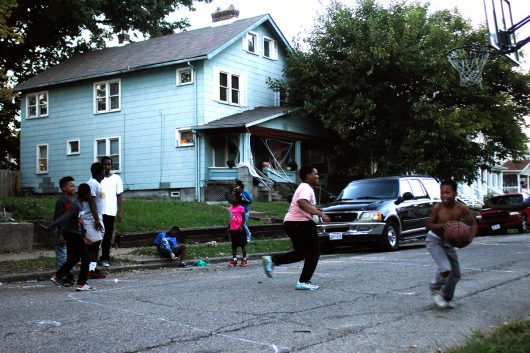
Kids play basketball on the evening of Tuesday, Oct. 4 in Weinland Park off of N 5th St. Weinland Park remains the highest density area of affordable housing in the city of Columbus, despite developers introduction of higher priced residential developments to the area. Credit: Grace Fleisher | Lantern Reporter
The Weinland Park Neighborhood Plan began in the spring of 2004 through the creation of a neighborhood working committee. The committee’s agenda sought to make the neighborhood a clean and safe place to live. But the reality was that gang violence and racial discrimination in the area were at their peak.
While the neighborhood still adheres to these priorities and challenges remain, Weinland Park now stands as the highest density affordable housing neighborhood in the city. The committee’s main focus has become maintaining the neighborhood’s integrity and housing diversity.
Following approval by the University Area Commission meeting on Sept. 22, Grant Park, a $54- million-dollar investment by Wagenbrenner Development, has been approved to further the residential expansion in Weinland Park by 21.5 acres, with homes starting at $246,699.
“The revitalization of Weinland Park has been providing and is to continue to provide great economic diversity,” said Evelyn Van Til, resident of Weinland Park and member of Weinland Park Community Civic Association. “The disinvestment of an area of industrialization left behind in the ’80s is being reinvented in an attempt to provide everything from Section 8 housing to market-rate homes.”
Weinland Park’s newest development, Grant Park, will contain more than 200 apartments, 12 apartment-style townhomes, 60 condo flats, 10 for-sale duplex units, 34 townhomes and a 42-unit residential building, according to the development plan submitted by Wagenbrenner and approved by the University Area Commission. The site’s plan also includes a 1-acre park at East Sixth Avenue.
Construction of Grant Park is set to begin in early 2017. The new development is to be located on a former industrial site of Columbus Coated Fabrics, and has had its soil treated to remove impurities, Van Til said.
“While this is going to be an enormous shift, it’s a positive thing and it’s one based on decisions made a long way back,” said Sean Storey, chair of the Weinland Park Community Civic Association’s Housing Committee. “Weinland Park wants to have a community with different types of income, and we’ve worked really hard over the years to get to this point. Affordable housing is not going away, and high incomes in the neighborhood will help it.”
A collaborative effort to improve the area has been taking place in Weinland Park for the last 12 years, one that community members and the university have noticed.
“It’s not perfect, but it’s the city working together to provide a mixed range of properties from ones that have historically been abandoned,” Van Til said. “Developers are working in all of Columbus to preserve not only Weinland Park, but the integrity of the Short North and the University District, which can be difficult in a city that’s struggled with economic and racial discrimination.”
While students might not be living in areas directly a part of Weinland Park, Van Til said there is a role students can play as individuals living in the surrounding area.
“Students are first citizens, and with this comes being nice, to the community you are immediately living in and to the individuals living with families surrounding you,” Van Til said.


